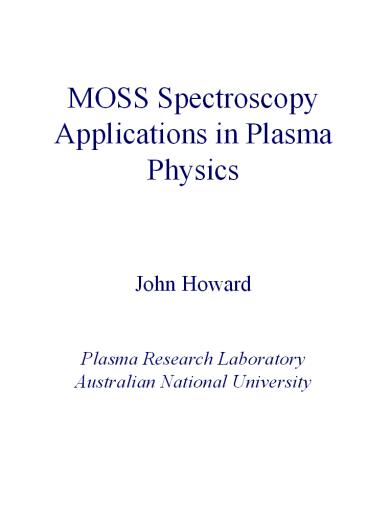MOSS Spectroscopy Applications in Plasma Physics - PowerPoint PPT Presentation
Title:
MOSS Spectroscopy Applications in Plasma Physics
Description:
Spherical quadrature polarimeter. Polarization Spectroscopy ... Combined polarimeter/MOSS system for MSE measurements. Spread Spectrum FTS. Spread Spectrum FTS ... – PowerPoint PPT presentation
Number of Views:63
Avg rating:3.0/5.0
Title: MOSS Spectroscopy Applications in Plasma Physics
1
MOSS Spectroscopy Applications in Plasma Physics
John Howard
Plasma Research LaboratoryAustralian National
University
2
Outline
- MOSS spectrometer
- Principle
- Doppler measurements on H-1
- Polarization Spectroscopy
- Zeeman effect and MSE
- Spread spectrum FTS
- Imaging systems
3
Fourier Transform Spectroscopy
4
MOSS Spectrometer
Concept
Instrument
5
Advantages of MOSS
- High light throughput
- High time resolution
- Compact, robust
MOSS is optimum in the sense that all photons
contribute to three independent pieces of
information - intensity, shift and contrast.
DC
Light intensity
atan(odd,even)
Flow velocity (shift)
sqrt(odd2even2)
Temperature (contrast)
6
MOSS Hardware
7
MOSS spectroscopy on H-1
Lines of sight
Central ring conductor
Plasma cross section
Fringe contrast versus time delayArII 488nm,
Ti10, (10), 100 eV
Nominal delay for LiNbO3 ( 25mm)
8
L-H Confinement Transitions
9
Heat Modulation Experiments
10
Fluctuation Measurements
11
Polarization Spectroscopy
- Zeeman Effect.
- The Zeeman components are spectrally shifted and
circularly polarized when viewed parallel to B.
The nett circular polarization is a measure of
the intensity weighted longitudinal component of
the B field.
Total lineshape
Relative intensity
LHCP
RHCP
Normalized wavelength
12
Polarization Spectroscopy
- By filtering/modulating the polarization state
of the plasma light using a spherical quadrature
polarimeter, either the coherence (bandwidth) or
centre of mass of the spectral line can be
varied. - The MOSS spectrometer senses these modulations as
contrast or phase variations of the
interferometer fringes.
Spherical quadrature polarimeter
13
Polarization Spectroscopy
- Motional Stark Effect.
- H or D atoms in a heating beam experience an
induced electric field E v x B that generates a
complex spectrum. Viewed transverse to E the
Stark split s and p components are polarized
respectively perpendicular and parallel to E.
Combined polarimeter/MOSS system for MSE
measurements
14
Spread Spectrum FTS
Spread Spectrum FTS
15
Imaging systems
Multiple spatial channels can be multiplexed
through an imaging MOSS spectrometer while
maintaining high light throughput and low
instrument temperature.Multiple-crystal
modulators can be employed for truly 2-D spectral
imaging the spectrum at each spatial position is
encoded in the temporal frequency domain.
16
Spread spectrum data at 587nm HeI
Plasma light
Calibrationlaser pulse
Laser interferogram
time (ms)
Power spectrum of interferogram
17
Conclusion
- MOSS spectroscopy is a high throughput
alternative to traditional grating spectrometers - Well suited to plasma Doppler and polarization
spectroscopy - Fully 2-D spectral imaging is possible.
- Facilitates tomography of scalar (intensity) and
vector (velocity) fields in H-1NF for force
balance, fluctuation and particle/heat modulation
studies































